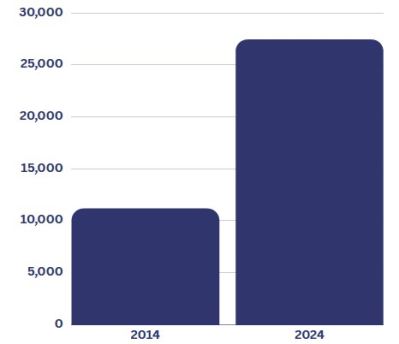Prekindergarten Data
The Office of Early Learning has created this resource in an effort to provide timely access to prekindergarten data. Typical data requests include counts of prekindergarten children served and counts and types of prekindergarten programs providing such services. This resource may be useful to school districts’ Boards of Education, advocacy groups, researchers, educators, students, and their families. Users are also encouraged to access provided resources and research which share the long-term effects and benefits of an early start for children in prekindergarten.
New York State (NYS) Administered Prekindergarten Fast Facts
The New York State (NYS) Administered Prekindergarten Fast Facts provides an overview of State and federally funded prekindergarten programs, including the research-based benefits of such programs.
Disclaimer
There are differences in the data provided within this resource when compared to data provided in the New York State Education Department’s Education at a Glance public data website. Such differences are summarized in the table below.
| NYSED’s Education at a Glance | OEL’s Data Webpage |
|
|
|
|
|
|
Please contact the Office of Early Learning for further clarification and verification of the data provided in this resource.
Data Resources
School year enrollment data is available when it is finalized the following September. Data for the 2024-2025 school year became available in September 2025.
- Prekindergarten Students Served
- Prekindergarten Students' Demographics
OEL has compiled demographics data for prekindergarten students served in New York State Administered Prekindergarten programs for the above listed school years. There are differences in the prekindergarten data provided by OEL resources when compared to data provided in the New York State Education Department’s Education at a Glance public data website. Child counts from NYSED's Education at a Glance website are based on traditional BEDS Day, the first Wednesday in October each year. Child counts from OEL resources are based on NYSED’s Child Counts Day for PreK in mid-March each year. As a result, OEL's 2021-2022 counts of half-day and full-day prekindergarten students are greater by 642 (3.3%) and 8,070 (6.5%) students, respectively. Calculated counts of prekindergarten students have been adjusted using these proportions.
The New York State Education Department defines Emergent Multilingual Learners (EML) as prekindergarten students who enter prekindergarten with a home or primary language other than English. The Office of Early Learning and the Office of Bilingual Education & English as a New Language provide resources to support serving EMLs. EML data is self-reported by State-Administered Prekindergarten programs in annual NYS Prekindergarten Final Program Reports.
Research Supporting Prekindergarten
National Institute for Early Education Research (NIEER)
The National Institute for Early Education Research (NIEER) improves the learning and development of young children by producing and communicating knowledge that transforms policy and practice. NIEER collaborates with a network of local, state, national, and international leaders to design, conduct, and disseminate rigorous research, evaluation, and policy analysis. NIEER also helps prepare the next generation of inspirational leaders and researchers in early education. NIEER publishes its annual State of Preschool Yearbook.
NYS Early Childhood Advisory Council (NYSECAC)'s Early Childhood Data Dashboard
The New York State Early Childhood Advisory Council (NYSECAC) provides strategic direction and advice to the Governor and State of New York on early childhood issues. By monitoring and guiding the implementation of a range of strategies, the ECAC supports New York in building a comprehensive and sustainable early childhood system that will ensure success for all young children. Its Early Childhood Data Dashboard includes information about demographics, available slots, and childcare market rates.
The Long-Term Effects of Universal Preschool in Boston
This National Bureau of Economic Research (NBER) working paper explores the effects of large-scale public preschool in Boston on college-going, college preparation, standardized test scores, and behavioral outcomes.
The High/Scope Perry Preschool Study Through Age 40
The High/Scope Perry Preschool study is a scientific experiment that has identified both the short- and long-term effects of a high quality preschool education program for young children living in poverty. The findings of program effects through age 40 span the domains of education, economic performance, crime prevention, family relationships, and health. Key findings for education, economic performance, and crime prevention are summarized.
The Foundation for Child Development
The Foundation for Child Development is a national, private philanthropy that identifies needs and fill gaps by connecting research to changes that continuously improve policy and practice. They provide the evidence, analysis and recommendations needed to implement early childhood systems that work for all children.
New York State Education Data and Research Hub
As a pilot project for Cornell University's Repository for Engaging Data (R.E.D.), the Education Data Hub serves as a primary source of both pre-prepared tools and raw data for a wealth of factors surrounding public education in New York State. Data is collected in conjunction with Cornell's Program on Applied Demographics (PAD), the Community and Regional Development Institute (CARDI) and the New York State Rural Schools Association (RSA).
Key Terms
|








